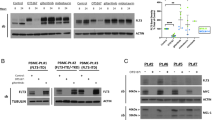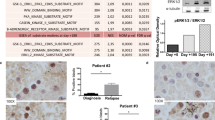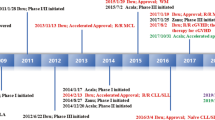Abstract
Constitutively active internal tandem duplication (ITD) in the juxtamembrane domain of Fms-like tyrosine kinase 3 (FLT3), a type III receptor tyrosine kinase, is the most common molecular defect associated with acute myeloid leukemia. Its presence confers a poor outcome in patients with acute myeloid leukemia who receive conventional chemotherapy. FLT3-ITD has therefore been considered to be an attractive molecular target for a novel therapeutic modality. We describe here the identification and characterization of Ki23819 as a novel FLT3 inhibitor. Ki23819 suppressed proliferation and induced apoptosis of FLT3-ITD-expressing human leukemia cell lines. The growth-inhibitory effect of Ki23819 on MV4-11 cells was superior to that of SU11248, another FLT3 inhibitor (IC50<1 vs 3–10?nM). Ki23819 inhibited the autophosphorylation of FLT3-ITD more efficiently than that of wild-type FLT3. FLT3-ITD-dependent activation of the downstream signaling proteins ERK and STAT5 was also inhibited within similar concentration ranges. Thus, Ki23819 is a potent in vitro inhibitor of FLT3.
This is a preview of subscription content, access via your institution
Access options
Subscribe to this journal
Receive 12 print issues and online access
$259.00 per year
only $21.58 per issue
Buy this article
- Purchase on Springer Link
- Instant access to full article PDF
Prices may be subject to local taxes which are calculated during checkout






Similar content being viewed by others
References
Rosnet O, Marchetto S, deLapeyriere O, Birnbaum D . Murine Flt3, a gene encoding a novel tyrosine kinase receptor of the PDGFR/CSF1R family. Oncogene 1991; 6: 1641–1650.
Gilliland DG, Griffin JD . The roles of FLT3 in hematopoiesis and leukemia. Blood 2002; 100: 1532–1542.
Stirewalt DL, Radich JP . The role of FLT3 in haematopoietic malignancies. Nat Rev Cancer 2003; 3: 650–665.
Blume-Jensen P, Hunter T . Oncogenic kinase signalling. Nature 2001; 411: 355–365.
Kiyoi H, Towatari M, Yokota S, Hamaguchi M, Ohno R, Saito H et al. Internal tandem duplication of the FLT3 gene is a novel modality of elongation mutation which causes constitutive activation of the product. Leukemia 1998; 12: 1333–1337.
Nakao M, Yokota S, Iwai T, Kaneko H, Horiike S, Kashima K et al. Internal tandem duplication of the flt3 gene found in acute myeloid leukemia. Leukemia 1996; 10: 1911–1918.
Yokota S, Kiyoi H, Nakao M, Iwai T, Misawa S, Okuda T et al. Internal tandem duplication of the FLT3 gene is preferentially seen in acute myeloid leukemia and myelodysplastic syndrome among various hematological malignancies. A study on a large series of patients and cell lines. Leukemia 1997; 11: 1605–1609.
Meshinchi S, Woods WG, Stirewalt DL, Sweetser DA, Buckley JD, Tjoa TK et al. Prevalence and prognostic significance of Flt3 internal tandem duplication in pediatric acute myeloid leukemia. Blood 2001; 97: 89–94.
Kottaridis PD, Gale RE, Frew ME, Harrison G, Langabeer SE, Belton AA et al. The presence of a FLT3 internal tandem duplication in patients with acute myeloid leukemia (AML) adds important prognostic information to cytogenetic risk group and response to the first cycle of chemotherapy: analysis of 854 patients from the United Kingdom Medical Research Council AML 10 and 12 trials. Blood 2001; 98: 1752–1759.
Thiede C, Steudel C, Mohr B, Schaich M, Schakel U, Platzbecker U et al. Analysis of FLT3-activating mutations in 979 patients with acute myelogenous leukemia: association with FAB subtypes and identification of subgroups with poor prognosis. Blood 2002; 99: 4326–4335.
Schnittger S, Schoch C, Dugas M, Kern W, Staib P, Wuchter C et al. Analysis of FLT3 length mutations in 1003 patients with acute myeloid leukemia: correlation to cytogenetics, FAB subtype, and prognosis in the AMLCG study and usefulness as a marker for the detection of minimal residual disease. Blood 2002; 100: 59–66.
Yamamoto Y, Kiyoi H, Nakano Y, Suzuki R, Kodera Y, Miyawaki S et al. Activating mutation of D835 within the activation loop of FLT3 in human hematologic malignancies. Blood 2001; 97: 2434–2439.
Abu-Duhier FM, Goodeve AC, Wilson GA, Care RS, Peake IR, Reilly JT . Identification of novel FLT-3 Asp835 mutations in adult acute myeloid leukaemia. Br J Haematol 2001; 113: 983–988.
Hayakawa F, Towatari M, Kiyoi H, Tanimoto M, Kitamura T, Saito H et al. Tandem-duplicated Flt3 constitutively activates STAT5 and MAP kinase and introduces autonomous cell growth in IL-3-dependent cell lines. Oncogene 2000; 19: 624–631.
Mizuki M, Fenski R, Halfter H, Matsumura I, Schmidt R, Muller C et al. Flt3 mutations from patients with acute myeloid leukemia induce transformation of 32D cells mediated by the Ras and STAT5 pathways. Blood 2000; 96: 3907–3914.
Kiyoi H, Ohno R, Ueda R, Saito H, Naoe T . Mechanism of constitutive activation of FLT3 with internal tandem duplication in the juxtamembrane domain. Oncogene 2002; 21: 2555–2563.
Murata K, Kumagai H, Kawashima T, Tamitsu K, Irie M, Nakajima H et al. Selective cytotoxic mechanism of GTP-14564, a novel tyrosine kinase inhibitor in leukemia cells expressing a constitutively active Fms-like tyrosine kinase 3 (FLT3). J Biol Chem 2003; 278: 32892–32898.
Kelly LM, Liu Q, Kutok JL, Williams IR, Boulton CL, Gilliland DG . FLT3 internal tandem duplication mutations associated with human acute myeloid leukemias induce myeloproliferative disease in a murine bone marrow transplant model. Blood 2002; 99: 310–318.
Kelly LM, Yu JC, Boulton CL, Apatira M, Li J, Sullivan CM et al. CT53518, a novel selective FLT3 antagonist for the treatment of acute myelogenous leukemia (AML). Cancer Cell 2002; 1: 421–432.
Levis M, Tse KF, Smith BD, Garrett E, Small D . A FLT3 tyrosine kinase inhibitor is selectively cytotoxic to acute myeloid leukemia blasts harboring FLT3 internal tandem duplication mutations. Blood 2001; 98: 885–887.
Weisberg E, Boulton C, Kelly LM, Manley P, Fabbro D, Meyer T et al. Inhibition of mutant FLT3 receptors in leukemia cells by the small molecule tyrosine kinase inhibitor PKC412. Cancer Cell 2002; 1: 433–443.
Yee KW, O'Farrell AM, Smolich BD, Cherrington JM, McMahon G, Wait CL et al. SU5416 and SU5614 inhibit kinase activity of wild-type and mutant FLT3 receptor tyrosine kinase. Blood 2002; 100: 2941–2949.
O'Farrell AM, Abrams TJ, Yuen HA, Ngai TJ, Louie SG, Yee KW et al. SU11248 is a novel FLT3 tyrosine kinase inhibitor with potent activity in vitro and in vivo. Blood 2003; 101: 3597–3605.
Levis M, Allebach J, Tse KF, Zheng R, Baldwin BR, Smith BD et al. A FLT3-targeted tyrosine kinase inhibitor is cytotoxic to leukemia cells in vitro and in vivo. Blood 2002; 99: 3885–3891.
Fiedler W, Mesters R, Tinnefeld H, Loges S, Staib P, Duhrsen U et al. A phase 2 clinical study of SU5416 in patients with refractory acute myeloid leukemia. Blood 2003; 102: 2763–2767.
Giles FJ, Stopeck AT, Silverman LR, Lancet JE, Cooper MA, Hannah AL et al. SU5416, a small molecule tyrosine kinase receptor inhibitor, has biologic activity in patients with refractory acute myeloid leukemia or myelodysplastic syndromes. Blood 2003; 102: 795–801.
Smith BD, Levis M, Beran M, Giles F, Kantarjian H, Berg K et al. Single-agent CEP-701, a novel FLT3 inhibitor, shows biologic and clinical activity in patients with relapsed or refractory acute myeloid leukemia. Blood 2004; 103: 3669–3676.
Stone RM, De Angelo J, Galinsky I, Estey E, Klimek V, Grandin W et al. PKC 412 FLT3 inhibitor therapy in AML: results of a phase II trial. Ann Hematol 2004; 83 (Suppl 1): S89–S90.
Rosnet O, Schiff C, Pebusque MJ, Marchetto S, Tonnelle C, Toiron Y et al. Human FLT3/FLK2 gene: cDNA cloning and expression in hematopoietic cells. Blood 1993; 82: 1110–1119.
Niwa H, Yamamura K, Miyazaki J . Efficient selection for high-expression transfectants with a novel eukaryotic vector. Gene 1991; 108: 193–199.
Chomczynski P, Sacchi N . Single-step method of RNA isolation by acid guanidinium thiocyanate–phenol–chloroform extraction. Anal Biochem 1987; 162: 156–159.
Graham FL, van der Eb AJ . A new technique for the assay of infectivity of human adenovirus 5 DNA. Virology 1973; 52: 456–467.
Kurokawa M, Mitani K, Imai Y, Ogawa S, Yazaki Y, Hirai H . The t(3;21) fusion product, AML1/Evi-1, interacts with Smad3 and blocks transforming growth factor-beta -mediated growth inhibition of myeloid cells. Blood 1998; 92: 4003–4012.
Morgan MA, Dolp O, Reuter CW . Cell-cycle-dependent activation of mitogen-activated protein kinase kinase (MEK-1/2) in myeloid leukemia cell lines and induction of growth inhibition and apoptosis by inhibitors of RAS signaling. Blood 2001; 97: 1823–1834.
Yee KW, Schittenhelm M, O'Farrell AM, Town AR, McGreevey L, Bainbridge T et al. Synergistic effect of SU11248 with cytarabine or daunorubicin on FLT3 ITD-positive leukemic cells. Blood 2004; 104: 4202–4209.
Griffith J, Black J, Faerman C, Swenson L, Wynn M, Lu F et al. The structural basis for autoinhibition of FLT3 by the juxtamembrane domain. Mol Cell 2004; 13: 169–178.
Hubbard SR . Juxtamembrane autoinhibition in receptor tyrosine kinases. Nat Rev Mol Cell Biol 2004; 5: 464–471.
Mizuki M, Schwable J, Steur C, Choudhary C, Agrawal S, Sargin B et al. Suppression of myeloid transcription factors and induction of STAT response genes by AML-specific Flt3 mutations. Blood 2003; 101: 3164–3173.
Acknowledgements
We thank Dr O Rosnet for providing FLT3 cDNA and Dr K Mitani for her helpful discussions.
Author information
Authors and Affiliations
Corresponding author
Rights and permissions
About this article
Cite this article
Komeno, Y., Kurokawa, M., Imai, Y. et al. Identification of Ki23819, a highly potent inhibitor of kinase activity of mutant FLT3 receptor tyrosine kinase. Leukemia 19, 930–935 (2005). https://doi.org/10.1038/sj.leu.2403736
Received:
Accepted:
Published:
Issue Date:
DOI: https://doi.org/10.1038/sj.leu.2403736
Keywords
This article is cited by
-
Hes1 suppresses acute myeloid leukemia development through FLT3 repression
Leukemia (2015)
-
Correlation analysis of p53 protein isoforms with NPM1/FLT3 mutations and therapy response in acute myeloid leukemia
Oncogene (2012)
-
Downstream molecular pathways of FLT3 in the pathogenesis of acute myeloid leukemia: biology and therapeutic implications
Journal of Hematology & Oncology (2011)
-
Drug resistance in mutant FLT3-positive AML
Oncogene (2010)
-
Pre-apoptotic response to therapeutic DNA damage involves protein modulation of Mcl-1, Hdm2 and Flt3 in acute myeloid leukemia cells
Molecular Cancer (2007)



